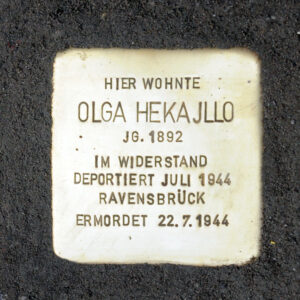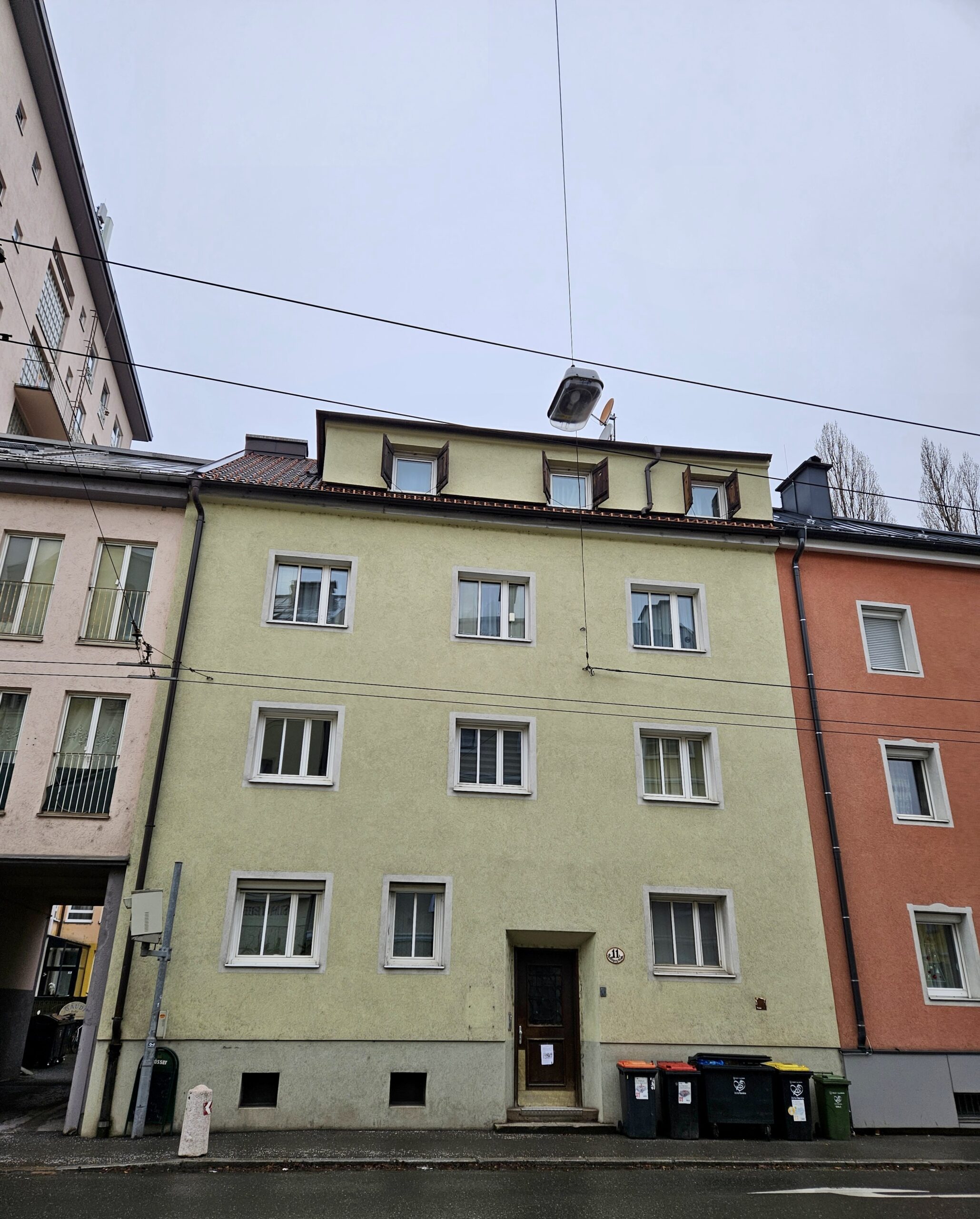Olga HEKAJLLO was born in Lemberg (Lwów, Lwiw), Galicia (then part of the Austrian half of Austria-Hungary) on January 20, 1892. She was the oldest child of a Catholic couple, an army officer named Sigmund HEKAJLLO who was stationed there and his wife Bertha.
Bertha was the daughter of Major General Alois Edler von Schuschnigg and his wife Katharina who had made the city of Salzburg their retirement home according to the High-Life-Almanac of the Austrian Society of Crown-Land Salzburg.
The von Schuschniggs lived at 5 Hubert Sattlergasse, and so did their daughter Bertha HEKAJLLO after May 1903. She had separated from her husband and lived with her two children, Olga and Wladimir-Felician.
Olga graduated from the Ursulines’ teacher training institute and remained unmarried as teacher regulations required at the time. She taught in elementary schools in rural districts and then in the city of Salzburg. From 1937 on she lived in the house of Medical Councilor Dr. Matthias Deissl at 11 Haunspergstraße – in the Elisabethvorstadt neighborhood.
According to the Police Registration records Olga HEKAJLLO was »officially deregistered« – along with the notation that »during the war she died in a concentration camp«.
It hasn’t been possible to identify the concentration camp with any certainty as even the records of the International Tracing Service in Bad Arolsen have no information about her. The lack of records could leave us to guess that Olga HEKAJLLO was murdered in the Ravensbrück concentration camp for women because that is where the SS destroyed all their records in the last days of the war.
The fate of this woman dragged off to a concentration camp would remain forever unknown if she hadn’t been the cousin of Dr. Kurt Schuschnigg, the Austrian Chancellor from 1934 to 1938.
But she was, and his son’s memoir gives the fate of Olga HEKAJLLO some shape. Schuschnigg writes that she is said to have listened to the »enemy radio station« BBC London and to have been overheard passing some news on to her grocer.
When the eavesdropper denounced Olga HEKAJLLO to the Gestapo they arrested the 52 year old teacher. As was often the case with women arrested by the Gestapo she wasn’t charged and tried for any crime, but was simply deported to the Ravensbrück concentration camp – as she informed her brother in a note dated July 24, 1944.
Her brother also received an urn from the concentration camp administration along with a document giving her official cause of death as »acute pneumonia« and stating that she had died on »July 22, 1944«, two days before the date on her note. [Kurt von Schuschnigg and Janet von Schuschnigg, When Hitler Took Austria: A Memoir of Heroic Faith by the Chancellor’s Son (San Francisco 2012), page 136.]
Recent research has shown that the information in the memoirs of Kurt von Schuschnigg is quite different in detail form that in a report of the Gestapo Salzburg to the Reichs Governor Dr. Scheel.
The Gestapo report from November 20, 1944 says that because of her opposition to National Socialism Olga HEKAJLLO was sent to a concentration camp on November 4, 1944 (and she was registered as prisoner # 84387 in the Ravensbrück concentration camp on November 17, 1944) – long after von Schuschnigg said she had been reported dead.
Although Hekajillo was strongly suspected of having listened to foreign radio stations there was no solid evidence for it so it seems that it was her earlier political opposition to the Nazi regime that led the Gestapo to decide to send her to a concentration camp on November 4, 1944.
An investigation had already been launched against Hekajllo back in September 1940 after it had been reported that while recuperating in Italy she had expressed herself in an extremely hateful manner about National Socialism and the conditions in the Reich.
After that she was under observation by the Gestapo and she had recently been in close contact with people known for their opposition to the regime.
Gestapo-Report November 20, 1944
Olga HEKAJLLO was an oppositional woman and was socialized to be a committed Catholic. That is known. But who were the perpetrators? Who observed and denounced Olga HEKAJLLO at 11 Haunspergstraße?
It is instructive that on September 12, 1944 the Gestapo also arrested two of Olga HEKAJLLO’s neighbors: Mathilde and Wilhelm Lamminger, a couple who were also the victims of a denunciation – but unlike Olga HEKAJLLO they weren’t dragged off to a concentration camp, they were brought before a court instead and charged with listening to enemy broadcasts and other offenses.
The Lammingers survived the liberation in May 1945, but they were only able to return to their apartment (which had been cleared out and occupied by the Gestapo) after a delay.
The police registration files show that these politically persecuted residents at 11 Haunspergstraße had a dangerous neighbor who lived there from 1938 to 1945: Gestapo officer Alois Würzl, Criminal-Secretary and SS-Untersturmführer.
Until recently it was entirely unknown that in the liberation year of 1945 a notorious Salzburg Gestapo agent named Georg König was interrogated about the Olga HEKAJLLO case by a US Counter Intelligence Corps (CIC) officer while he was interned in Camp Marcus W. Orr (Lager Glasenbach).
On July 31, Georg König stated for the record that Olga HEKAJLLO had been arrested by her neighbor, Gestapo officer Alois Würzl. Furthermore, he stated that Würzl had seized for himself the valuables in the expropriated apartment – that is he had robbed their victim.
And while König only admitted that he had also taken part in searching the apartment, survivors like the Lammingers reported that Georg König tortured them to force them to sign the confessions that he submitted to the court at their trials.
Another Gestapo agent, Criminal Secretary Rudolf Höfelsauer, also profited from the persecution of Olga HEKAJLLO – he was given her apartment for his own residence and he continued to live there until Salzburg was liberated in 1945.
So the Gestapo agents shared the loot and then ensured that Olga HEKAJLLO was murdered in the Ravensbrück concentration camp. She was prevented from leaving any testimony about her suffering, so her brother Wladimir-Felician (who was never persecuted on political grounds or for his relationship to former Chancellor Kurt Schuschnigg) remained ignorant about the brutal end of his sister’s life.
It is worth noting that Olga HEKAJLLO is one of those victims of the Nazi terror whose fate was left out of both the Documentation on Resistance and Persecution in Salzburg 1934-1945 [Dokumentation Widerstand und Verfolgung in Salzburg 1934-1945] published in 1991 and the on-line victims’ register of the Documentation Archives of the Austrian Resistance (DÖW).
Sources
- Salzburg City and State archives
- Austrian women in Ravensbrück (Databank of Victims)
Translation: Stan Nadel
Stumbling Stone
Laid 18.04.2013 at Salzburg, Haunspergstraße 11




